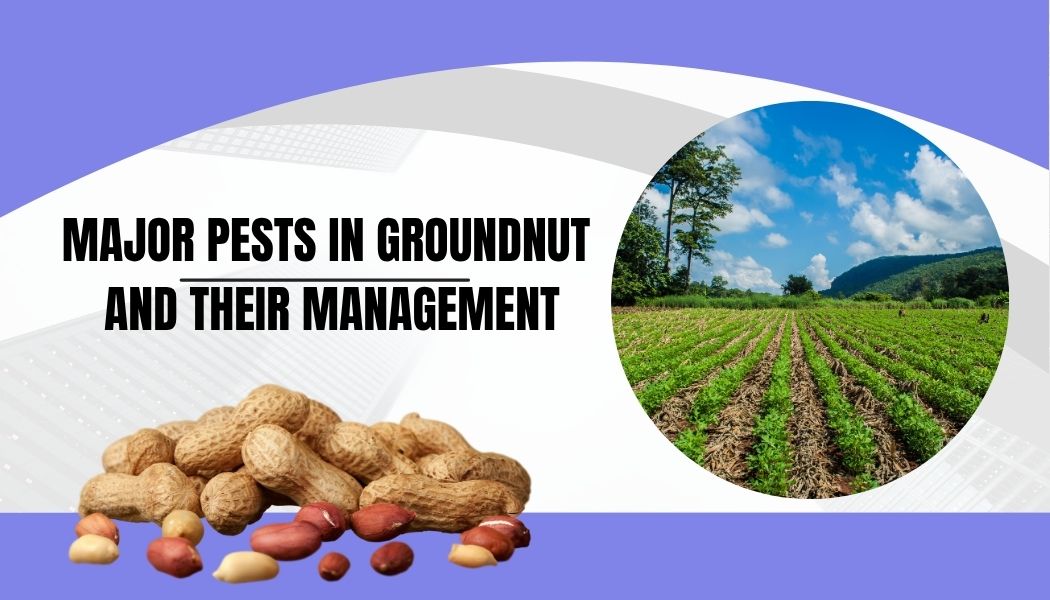
MAJOR PESTS IN GROUNDNUT AND THEIR MANAGEMENT
INTRODUCTION
Groundnut, an important oilseed and food crop, is highly susceptible to a variety of insect pests that can significantly impact its productivity and quality. Among the most prominent pests are the leaf miner, red hairy caterpillar, Bihar hairy caterpillar, tobacco caterpillar, and pod borer. These pests attack various parts of the plant, including leaves, stems, and pods, causing defoliation, reduced photosynthesis, and direct damage to the yield. The present topic will give details about the Major groundnut pests and management practices.
List of pests in groundnut:
- Leaf minor
- Red hairy caterpillar
- Gram pod borer
- Tobacco caterpillar
- Thrips
- Aphids
- Leaf hopper
- Whitegrub
- Bihar hairy caterpillar
1. Leaf minor
Scientific name: Aproaerema modicella
SYMPTOMS
- Young larvae mine into the leaves and feed the leaflets.
- Short brownish blotches on the leaflets.
- Grown up larvae web the leaflets together, feed on tissues and form brown blister-like blotches.
- In severe infestation, damaged leaflets roll, shrivel, dry up and gives a burnt appearance.
MANAGEMENT
ETL: 1 larva /meter row
- Sow groundnut early and synchronously in rainy and rabi season.
- Intercrop groundnut with pearl millet @ 4:1 ratio.
- Set up light trap @ 1/ha between 8 and 11 PM at ground level.
- Mulch the soil with straw within 10 days after germination wherever possible.
- Avoid water stress in irrigated crop to avoid the pest infestation.
- Maintain the fields and bunds free from weeds.
- For effective control of Caterpillar in groundnut bio pesticide like “LARVEX 250 ml / acre” can be used.
2. Red hairy caterpillar
Scientific name: Amsacta albistriga and Amsacta moorei
SYMPTOMS
- Young larvae scrap the undersurface of leaves and the leaves become papery.
- Grown up larvae devour the entire foliage, leaving the main stem as the field grazed by cattle.
MANAGEMENT
- Deep summer ploughing to destroy the pupa.
- Early sowing to escape from pest damage.
- Crop rotation with sorghum or pearl millet or maize will reduce pest infestation.
- Irrigate the field to avoid prolonged mid-season drought to prevent infestation.
- Install a light trap @ 1/ ha or bonfires immediately at the onset of rains to attract and kill the moths in endemic areas.
- Collect and destroy egg masses and early instar larvae in the damaged fields.
- Dig out a trench around the field to avoid the migration of caterpillars and kill them.
- Conserve natural enemies viz., spiders,coccinellids, chrysopids, parasitoids Bracon and Chelonus spp., by intercropping with pigeon pea and mung bean.
- For effective control of Caterpillar in groundnut bio pesticide like “LARVEX 250 ml / acre” can be used.
3. Gram pod borer
Scientific name: Helicoverpa armigera
SYMPTOMS
- Larvae feed on the foliage, prefers flowers and buds.
- When tender leaf buds are eaten symmetrical holes or cuttings can be seen upon unfolding of leaflets.
MANAGEMENT
- Follow summer ploughing to expose pupae to sunlight and bird.
- Crop rotation with sorghum, maize, pearl millet and sugarcane minimize the infestation.
- Install pheromone traps @ 5 /ac to monitor and kill the male moths.
- Set up light trap @ 1 / ha to attract and kill the moths.
- Spray HaNPV @ 100 LE/ac or B.t (Bacillus thuringiensis) @ 400 kg/ac to manage early instar larvae.
- Use Trichogramma chilonis @ 1 lakh/ha or Chrysoperla carnea @ 50000/ha at 40 and 50 days after sowing of groundnut can effectively check the pest.
- For effective control of Caterpillar in groundnut bio pesticide like “LARVEX 250 ml / acre” can be used.
4. Tobacco caterpillar
Scientific name: Spodoptera litura
SYMPTOMS
- Scrapping of the leaves by freshly hatched larvae.
- Grown up larvae feed the entire leaf leaving petioles alone looks the field grazed by cattle.
- Since this pest is nocturnal in habit larvae hide under the plants, cracks and crevices of soil and debris during the day time.
- Faecal pellets are seen on the leaves and on the ground which is the indicator of the pest incidence.
MANAGEMENT
ETL: 8 egg masses /100 m row
- Follow summer ploughing to expose pupae to sunlight and bird.
- Grow castor as a border (or) intercrop to serve as an indicator (or) trap crop.
- Install light trap @ 1 /ha to monitor moths activity.
- Install pheromone traps @ 5 / ac to monitor and kill male moths.
- Collect and destroy egg masses, early stage larvae with lace-like leaves.
- Avoid larvae migration by digging a trench of 30cm deep and 25cm wide with perpendicular sides around the infested fields.
-
For effective control of Caterpillar in groundnut bio pesticide like “LARVEX 250 ml / acre” can be used.
5. Bihar hairy caterpillar
Scientific name: Spilosoma obliqua
SYMPTOMS
- Young larvae feed mostly on the under surface of the leaves
- Feed on leaves and causes defoliation.
- In severe infestation, whole plant eaten away leaving only the stems.
MANAGEMENT
- Pre-monsoon deep ploughing to expose the hibernating pupae to sunlight and predatory birds.
- Collect and destroy eggs and young caterpillars.
- For effective control of Caterpillar in groundnut bio pesticide like “LARVEX 250 ml / acre” can be used
FAQ’s
1.Which are the major pests of groundnut?
Major pests of groundnut are leafminer, red hairy caterpillar ,tobacco caterpillar, gram pod borer etc.
2.What are the cultural practices to manage groundnut pests?
Crop rotation, pest resistant varieties ,deep ploughing, and inter cropping with crops like maize or sorghum.
3.What are the symptoms of red hairy caterpillar infestation?
Red hairy caterpillar feeds on leaves, leaving only veins and severe infestations can result in complete defoliation.
4.How can leaf miners be controlled?
To control leaf miners we should follow cultural, biological and chemical control methods.
5.What are the symptoms of leaf miner infestation?
The larvae mine the leaf tissue ,causing leaflets to fold, dry and turn brown. Severe infestation leads to defoliation.
CONCLUSION
Optimal crop productivity and quality depend on the efficient control of important groundnut pests, such as the leaf miner, red hairy caterpillar, Bihar hairy caterpillar, tobacco caterpillar, and pod borer. Minimizing damage requires early pest detection, consistent monitoring, and quick actions. Integrated Pest Management (IPM) techniques offer a sustainable and environmentally responsible method of controlling pests by integrating chemical, biological, and cultural treatments.For effective control of caterpillars we can use bio pesticides like LARVEX’250ml/acre and for sucking pests Dr.Eliminator’250ml/acre can be used.
Larvex: https://www.khethari.com/search?q=larvex&options%5Bprefix%5D=last

Dr. Eliminator: https://www.khethari.com/products/dr-eliminator-insecticide?_pos=2&_sid=ce0403b43&_ss=r

